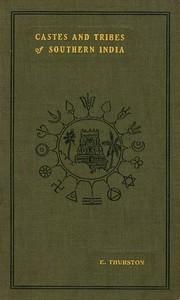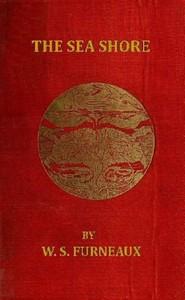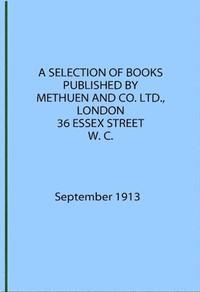|
|
Read this ebook for free! No credit card needed, absolutely nothing to pay.Words: 139015 in 25 pages
This is an ebook sharing website. You can read the uploaded ebooks for free here. No credit cards needed, nothing to pay. If you want to own a digital copy of the ebook, or want to read offline with your favorite ebook-reader, then you can choose to buy and download the ebook.

: Castes and Tribes of Southern India. Vol. 1 of 7 by Thurston Edgar Rangachari K Contributor - Caste India South; Tribes India South; Ethnology India South; India South Social life and customs@FreeBooksWed 07 Jun, 2023 y notes show that the hyperdolichocephalic type survives in the dolichocephalic inhabitants of the Tamil country at the present day:-- Class Number Cephalic index below 70. examined. Palli 40 64.4; 66.9; 67; 68.2; 68.9; 69.6. Paraiyan 40 64.8; 69.2; 69.3; 69.5. Vellala 40 67.9; 69.6. In describing the "Hindu type," Topinard divides the population of the Indian peninsula into three strata, viz., the Black, Mongolian, and the Aryan. "The remnants of the first," he says, "are at the present time shut up in the mountains of Central India under the name of Bhils, Mahairs, Ghonds, and Khonds; and in the south under that of Yenadis, Kurumbas, etc. Its primitive characters, apart from its black colour and low stature, are difficult to discover, but it is to be noticed that travellers do not speak of woolly hair in India. The second has spread over the plateaux of Central India by two lines of way, one to the north-east, the other to the north-west. The remnants of the first invasion are seen in the Dravidian or Tamil tribes, and those of the second in the Jhats. The third more recent, and more important as to quality than as to number, was the Aryan." In speaking further of the Australian type, characterised by a combination of smooth hair with Negroid features, Topinard states that "it is clear that the Australians might very well be the result of the cross between one race with smooth hair from some other place, and a really Negro and autochthonous race. The opinions held by Huxley are in harmony with this hypothesis. He says the Australians are identical with the ancient inhabitants of the Deccan. The features of the present blacks in India, and the characters which the Dravidian and Australian languages have in common, tend to assimilate them. The existence of the boomerang in the two countries, and some remnants of caste in Australia, help to support the opinion." Of the so-called boomerangs of Southern India, the Madras Museum possesses three from the Tanjore armoury . Concerning them, the Dewan of Pudukkottai writes to me as follows. "The valari or valai tadi is a short weapon, generally made of some hard-grained wood. It is also sometimes made of iron. It is crescent-shaped, one end being heavier than the other, and the outer end is sharpened. Men trained in the use of the weapon hold it by the lighter end, whirl it a few times over their shoulders to give it impetus, and then hurl it with great force against the object aimed at. It is said that there were experts in the art of throwing the valari, who could at one stroke despatch small game, and even man. No such experts are now forthcoming in the Pudukkottai State, though the instrument is reported to be occasionally used in hunting hares, jungle fowl, etc. Its days, however, must be counted as past. Tradition states that the instrument played a considerable part in the Poligar wars of the last century. But it now reposes peacefully in the households of the descendants of the rude Kallan and Maravan warriors, preserved as a sacred relic of a chivalric past, along with other old family weapons in their puja room, brought out and scraped and cleaned on occasions like the Ayudha puja day , and restored to its place of rest immediately afterwards." At a Kallan marriage, the bride and bridegroom go to the house of the latter, where boomerangs are exchanged, and a feast is held. This custom appears to be fast becoming a tradition. But there is a common saying still current "Send the valai tadi, and bring the bride." It is pointed out by Topinard, as a somewhat important piece of evidence, that, in the West, about Madagascar and the point of Aden in Africa, there are black tribes with smooth hair, or, at all events, large numbers of individuals who have it, mingled particularly among the Somalis and the Gallas, in the region where M. Broca has an idea that some dark, and not Negro, race, now extinct, once existed. At the meeting of the British Association, 1898, Mr. W. Crooke gave expression to the view that the Dravidians represent an emigration from the African continent, and discounted the theory that the Aryans drove the aboriginal inhabitants into the jungles with the suggestion that the Aryan invasion was more social than racial, viz., that what India borrowed from the Aryans was manners and customs. According to this view, it must have been reforming aborigines who gained the ascendancy in India, rather than new-comers; and those of the aborigines who clung to their old ways got left behind in the struggle for existence. In an article devoted to the Australians, Professor R. Semon writes as follows. "We must, without hesitation, presume that the ancestors of the Australians stood, at the time of their immigration to the continent, on a lower rung of culture than their living representatives of to-day. Whence, and in what manner, the immigration took place, it is difficult to determine. In the neighbouring quarter of the globe there lives no race, which is closely related to the Australians. Their nearest neighbours, the Papuans of New Guinea, the Malays of the Sunda Islands, and the Macris of New Zealand, stand in no close relationship to them. On the other hand, we find further away, among the Dravidian aborigines of India, types which remind us forcibly of the Australians in their anthropological characters. In drawing attention to the resemblance of the hill-tribes of the Deccan to the Australians, Huxley says: 'An ordinary cooly, such as one can see among the sailors of any newly-arrived East India vessel, would, if stripped, pass very well for an Australian, although the skull and lower jaw are generally less coarse.' Huxley here goes a little too far in his accentuation of the similarity of type. We are, however, undoubtedly confronted with a number of characters--skull formation, features, wavy curled hair--in common between the Australians and Dravidians, which gain in importance from the fact that, by the researches of Norris, Bleek, and Caldwell, a number of points of resemblance between the Australian and Dravidian languages have been discovered, and this despite the fact that the homes of the two races are so far apart, and that a number of races are wedged in between them, whose languages have no relationship whatever to either the Dravidian or Australian. There is much that speaks in favour of the view that the Australians and Dravidians sprang from a common main branch of the human race. According to the laborious researches of Paul and Fritz Sarasin, the Veddas of Ceylon, whom one might call pre-Dravidians, would represent an off-shoot from this main stem. When they branched off, they stood on a very low rung of development, and seem to have made hardly any progress worth mentioning." In dealing with the Australian problem, Mr. A. H. Keane refers to the time when Australia formed almost continuous land with the African continent, and to its accessibility on the north and north-west to primitive migration both from India and Papuasia. "That such migrations," he writes, "took place, scarcely admits of a doubt, and the Rev. John Mathew concludes that the continent was first occupied by a homogeneous branch of the Papuan race either from New Guinea or Malaysia, and that these first arrivals, to be regarded as true aborigines, passed into Tasmania, which at that time probably formed continuous land with Australia. Thus the now extinct Tasmanians would represent the primitive type, which, in Australia, became modified, but not effaced, by crossing with later immigrants, chiefly from India. These are identified, as they have been by other ethnologists, with the Dravidians, and the writer remarks that 'although the Australians are still in a state of savagery, and the Dravidians of India have been for many ages a people civilized in a great measure, and possessed of literature, the two peoples are affiliated by deeply-marked characteristics in their social system as shown by the boomerang, which, unless locally evolved, must have been introduced from India.' But the variations in the physical characters of the natives appear to be too great to be accounted for by a single graft; hence Malays also are introduced from the Eastern Archipelago, which would explain both the straight hair in many districts, and a number of pure Malay words in several of the native languages." Dealing later with the ethnical relations of the Dravidas, Mr. Keane says that "although they preceded the Aryan-speaking Hindus, they are not the true aborigines of the Deccan, for they were themselves preceded by dark peoples, probably of aberrant Negrite type." In the 'Manual of Administration of the Madras Presidency,' Dr. C. Macleane writes as follows. "The history proper of the south of India may be held to begin with the Hindu dynasties formed by a more or less intimate admixture of the Aryan and Dravidian systems of government. But, prior to that, three stages of historical knowledge are recognisable; first, as to such aboriginal period as there may have been prior to the Dravidian; secondly, as to the period when the Aryans had begun to impose their religion and customs upon the Dravidians, but the time indicated by the early dynasties had not yet been reached. Geology and natural history alike make it certain that, at a time within the bounds of human knowledge, Southern India did not form part of Asia. A large southern continent, of which this country once formed part, has ever been assumed as necessary to account for the different circumstances. The Sanscrit Pooranic writers, the Ceylon Boodhists, and the local traditions of the west coast, all indicate a great disturbance of the point of the Peninsula and Ceylon within recent times. Investigations in relation to race show it to be by no means impossible that Southern India was once the passage-ground, by which the ancient progenitors of Northern and Mediterranean races proceeded to the parts of the globe which they now inhabit. In this part of the world, as in others, antiquarian remains show the existence of peoples who used successively implements of unwrought stone, of wrought stone, and of metal fashioned in the most primitive manner. These tribes have also left cairns and stone circles indicating burial places. It has been usual to set these down as earlier than Dravidian. But the hill Coorumbar of the Palmanair plateau, who are only a detached portion of the oldest known Tamulian population, erect dolmens to this day. The sepulchral urns of Tinnevelly may be earlier than Dravidian, or they may be Dravidian.... The evidence of the grammatical structure of language is to be relied on as a clearly distinctive mark of a population, but, from this point of view, it appears that there are more signs of the great lapse of time than of previous populations. The grammar of the South of India is exclusively Dravidian, and bears no trace of ever having been anything else. The hill, forest, and Pariah tribes use the Dravidian forms of grammar and inflection.... The Dravidians, a very primeval race, take a by no means low place in the conjectural history of humanity. They have affinities with the Australian aborigines, which would probably connect their earliest origin with that people." Adopting a novel classification, Dr. Macleane, in assuming that there are no living representatives in Southern India of any race of a wholly pre-Dravidian character, sub-divides the Dravidians into pre-Tamulian and Tamulian, to designate two branches of the same family, one older or less civilised than the other. The importance, which has been attached by many authorities to the theory of the connection between the Dravidians and Australians, is made very clear from the passages in their writings, which I have quoted. Before leaving this subject, I may appropriately cite as an important witness Sir William Turner, who has studied the Dravidians and Australians from the standpoint of craniology. "Many ethnologists of great eminence," he writes, "have regarded the aborigines of Australia as closely associated with the Dravidians of India. Some also consider the Dravidians to be a branch of the great Caucasian stock, and affiliated therefore to Europeans. If these two hypotheses are to be regarded as sound, a relationship between the aboriginal Australians and the European would be established through the Dravidian people of India. The affinities between the Dravidians and Australians have been based upon the employment of certain words by both people, apparently derived from common roots; by the use of the boomerang, similar to the well-known Australian weapon, by some Dravidian tribes; by the Indian peninsula having possibly had in a previous geologic epoch a land connection with the Austro-Malayan Archipelago, and by certain correspondences in the physical type of the two people. Both Dravidians and Australians have dark skins approximating to black; dark eyes; black hair, either straight, wavy or curly, but not woolly or frizzly; thick lips; low nose with wide nostrils; usually short stature, though the Australians are somewhat taller than the Dravidians. When the skulls are compared with each other, whilst they correspond in some particulars, they differ in others. In both races, the general form and proportions are dolichocephalic, but in the Australians the crania are absolutely longer than in the Dravidians, owing in part to the prominence of the glabella. The Australian skull is heavier, and the outer table is coarser and rougher than in the Dravidian; the forehead also is much more receding; the sagittal region is frequently ridged, and the slope outwards to the parietal eminence is steeper. The Australians in the norma facialis have the glabella and supra-orbital ridges much more projecting; the nasion more depressed; the jaws heavier; the upper jaw usually prognathous, sometimes remarkably so." Of twelve Dravidian skulls measured by Sir William Turner, in seven the jaw was orthognathous, in four, in the lower term of the mesognathous series; one specimen only was prognathic. The customary type of jaw, therefore, was orthognathic. The conclusion at which Sir William Turner arrives is that "by a careful comparison of Australian and Dravidian crania, there ought not to be much difficulty in distinguishing one from the other. The comparative study of the characters of the two series of crania has not led me to the conclusion that they can be adduced in support of the theory of the unity of the two people." The Dravidians of Southern India are divided by Sir Herbert Risley into two main groups, the Scytho-Dravidian and the Dravidian, which he sums up as follows:-- "The Scytho-Dravidian type of Western India, comprising the Maratha Braahmans, the Kunbis and the Coorgs; probably formed by a mixture of Scythian and Dravidian elements, the former predominating in the higher groups, the latter in the lower. The head is broad; complexion fair; hair on face rather scanty; stature medium; nose moderately fine, and not conspicuously long. Free books android app tbrJar TBR JAR Read Free books online gutenberg More posts by @FreeBooks
: The Sea Shore by Furneaux William S Lillie R Illustrator - Seashore biology; Seashore; Marine biology Great Britain@FreeBooksWed 07 Jun, 2023

: A Selection of Books Published by Methuen & Co. September 1913 by Methuen Co - Publishers' catalogs England; Methuen & Co. Catalogs@FreeBooksWed 07 Jun, 2023
|
Terms of Use Stock Market News! © gutenberg.org.in2025 All Rights reserved.






